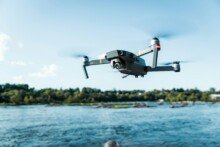In a world where innovation knows no bounds, the ascent of drones has been nothing short of meteoric. From personal recreation to commercial applications and even military operations, drones have soared into the mainstream consciousness, reshaping industries and redefining possibilities. Let’s delve into the captivating realm of next-gen drones and explore how they are propelling us into a future limited only by our imagination.
Introduction: The Drone Revolution Takes Flight
Drones, once confined to the realms of science fiction, are now ubiquitous in our skies. Their rise in popularity stems from their versatility and adaptability across various sectors. Whether it’s capturing breathtaking aerial footage, optimizing agricultural practices, or enhancing national security, drones have become indispensable tools in our modern toolkit.
Categories of Cutting-Edge Drones
Consumer Quadcopters and Photography Drones
Consumer drones have democratized aerial photography, putting the power of flight and cinematography into the hands of enthusiasts and professionals alike. Equipped with state-of-the-art features such as high-resolution cameras, GPS navigation, obstacle avoidance systems, and intuitive gesture controls, drones like the DJI Mavic and Skydio 2 have set the standard for excellence in aerial imaging.
Commercial Drones
The realm of commercial drones extends far beyond mere recreation, encompassing a diverse array of applications. From mapping and surveying vast terrains to conducting aerial inspections of infrastructure and crops, commercial drones are indispensable tools for industries seeking efficiency and precision. Leading the charge are models like the senseFly eBee X and Intel Falcon 8, renowned for their reliability and performance in demanding environments.
Military and Tactical Drones
In the realm of defense and security, drones play a pivotal role in reconnaissance, surveillance, and even combat operations. These military-grade drones boast advanced capabilities, including long-endurance flights, target acquisition systems, and the capacity to serve as formidable weapons platforms. Among them, the General Atomics MQ-9 Reaper stands tall as a testament to the fusion of technology and warfare.
Drone Technologies Powering the Future
Battery Capacities and Flight Times
The evolution of battery technology has been instrumental in extending drone flight times and enhancing overall performance. With innovations in lithium-polymer batteries and energy management systems, drones can now stay aloft for extended durations, opening up new possibilities for aerial exploration and data collection.
Lightweight Materials and Engineering
Advancements in materials science have led to the development of lightweight yet robust materials for drone construction. Carbon fiber, titanium alloys, and composite materials are increasingly being utilized to reduce weight without compromising structural integrity, resulting in drones that are agile, durable, and capable of navigating diverse environments with ease.
Sophisticated Cameras and Sensors
The integration of cutting-edge camera systems and sensors has transformed drones into powerful data-gathering platforms. From high-resolution cameras and multispectral sensors to LiDAR scanners and thermal imaging cameras, drones are equipped with an arsenal of tools for capturing and analyzing data across the electromagnetic spectrum.
Advanced Computer Vision and AI
Artificial intelligence and computer vision algorithms empower drones with autonomous capabilities, enabling them to perceive their surroundings, make intelligent decisions, and adapt to dynamic environments in real-time. From autonomous navigation and object recognition to predictive analytics and mission planning, AI is revolutionizing the way drones operate and interact with the world around them.
Enterprise Drone Industry Outlook
Market Size and Growth Projections
The global drone market continues to experience exponential growth, driven by increasing demand across various sectors. With market projections soaring into the billions, the drone industry shows no signs of slowing down, fueled by advancements in technology, regulatory support, and expanding applications.
Regulatory Landscape with FAA Rules
As drones become more prevalent, regulatory frameworks are evolving to ensure safe and responsible integration into airspace. The Federal Aviation Administration (FAA) plays a central role in establishing rules and guidelines for drone operations, balancing innovation with safety and privacy concerns to foster a thriving and sustainable drone ecosystem.
Key Trends like BVLOS Flights and Drone Deliveries
Beyond line-of-sight (BVLOS) operations and drone deliveries represent the next frontier in drone technology, unlocking new possibilities for logistics, transportation, and emergency response. With companies like Amazon and UPS pioneering drone delivery services, the future of autonomous aerial transportation is closer than ever before.
Conclusion: Navigating the Skies of Tomorrow
As we look ahead, the horizon brims with promise and possibility, propelled by the boundless potential of next-gen drones. From revolutionizing industries to shaping our collective future, these aerial marvels are rewriting the script of human innovation, ushering in an era where the sky is no longer the limit.
FAQs
What are the primary applications of commercial drones?
The primary applications of commercial drones include mapping, surveying, inspections, and monitoring in industries such as agriculture, construction, and infrastructure.
How do drones contribute to agricultural practices?
Drones are used in agriculture for crop monitoring, precision spraying, and mapping. They provide farmers with valuable data and insights to optimize crop health, reduce resource wastage, and increase yields.
What regulations govern drone operations in the United States?
The Federal Aviation Administration (FAA) governs drone operations in the United States. They have established rules and guidelines to ensure safe and responsible drone use, including registration requirements and restrictions on flying near airports and people.
Can drones be used for search and rescue missions?
Yes, drones have proven to be valuable tools in search and rescue missions. They can quickly cover large areas, provide aerial views, and deliver supplies to inaccessible locations, aiding in locating missing persons and providing assistance in emergency situations.
What role does artificial intelligence play in drone technology?
Artificial intelligence enables drones to operate autonomously, make intelligent decisions, and adapt to changing environments. AI algorithms power features like object recognition, autonomous navigation, and predictive analytics, enhancing the capabilities and efficiency of drones.
Are there any limitations to drone flight endurance?
While advancements in battery technology have extended drone flight times, there are still limitations. Factors such as payload weight, weather conditions, and the energy efficiency of the drone itself can impact flight endurance. However, ongoing research and development are focused on improving these limitations.

